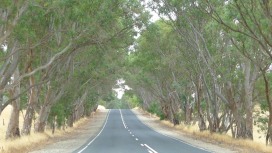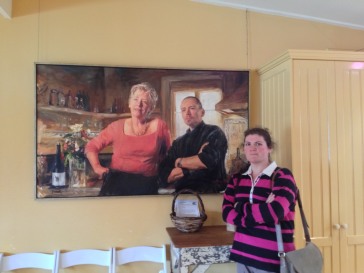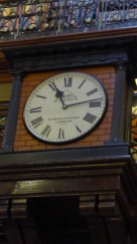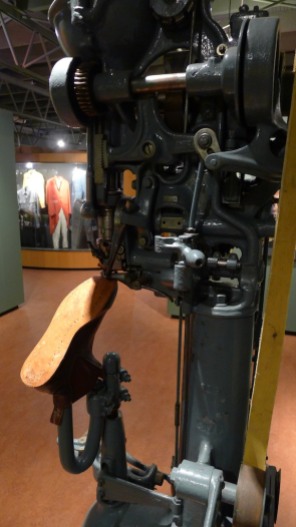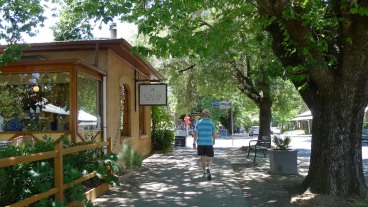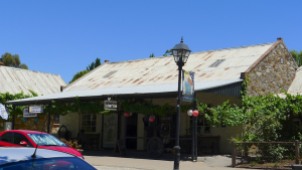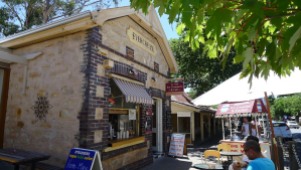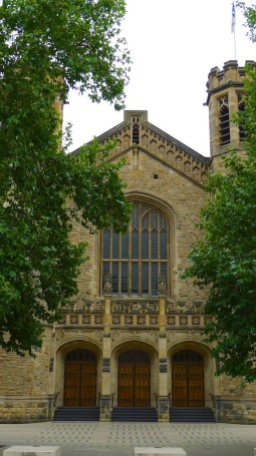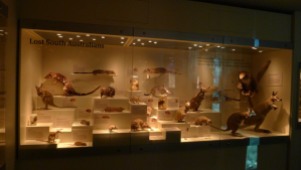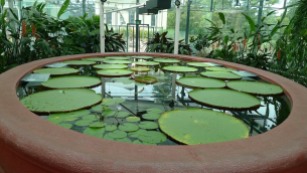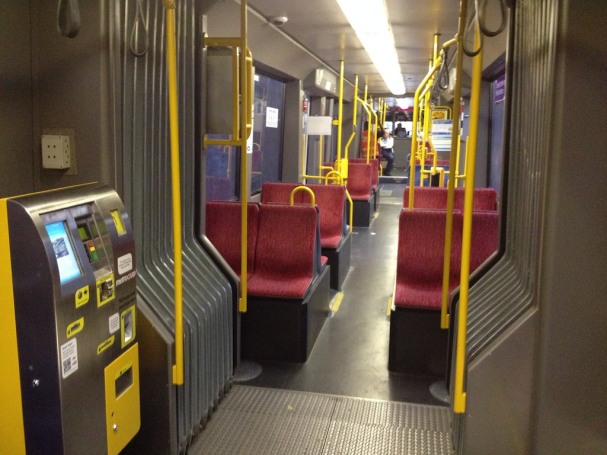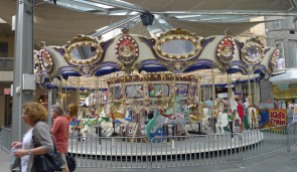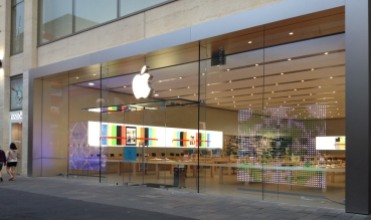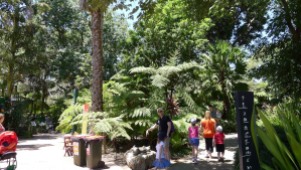THURSDAY
Today was a day of ups and downs – and not just because we were taking the Mini for a spin through the Adelaide Hills again.
The plan was to do a loop out to Birdwood to see the National Motor Museum, then head north to Nurioopta and Maggie Beer’s Farm Shop, then back down the highway stopping at the RM Williams factory at Salisbury if time permitted.
It’s not a short drive to Birdwood (at almost an hour) but once you’re out of the suburbs it’s a pleasant drive in the country. Keep your eye out for wildlife. I spotted an emu and a kangaroo (but where there’s one, there’s undoubtably more). Birdwood is one of the larger villages that you’ll pass through, thanks to the presence of the National Motor Museum.
More than a catalogue of cars made or assembled in Australia, the museum attempts to tell some of the stories of our motoring history. As a collection, Stephen thinks some cars could easily have been left out and not be missed, replaced with other cars that had a greater role in our motoring history. I’m not quite the motoring enthusiast he is, so didn’t really notice. Mind you, the museum is sponsored by Holden so there’s a bit of a bias there (which even I noticed), Ford is a little under-represented, and there is much more to tell about the story of Mitsubishi (of which there were a few cars) and Nissan (of which there were none).
For someone like me, who doesn’t know much about the history of car making, who’s first guess at the model of the really old style cars is always “Model T Ford?” (although lately, from that era, my favourite has to be a Hispano Suiza which – before you even think of thinking the question – is not part the collection), it was still interesting. There were short plaques to read, not everything was about cars per se – one of the interesting displays was a history of Shell.
Possibly my favourite display though was a short video on how a combustion engine works and is assembled. There was no narration, just a bit of background music to accompany the images. Having a rough idea of the various parts of a car engine helped (all those hours helping dad fix the cars weren’t for naught, it seems).
Finished at the museum and hoping for a pie for lunch, we tried the bakery across the street. At the back of a bit of a queue we heard that there were no pies left! Spotting another bakery back on the same side of the street as the museum (pretty much right next-door) we dived in, fingers crossed – it must have worked. Not only did they have a huge range of fresh, hot pies, by golly they were damn good as well! Tasty, and good consistency, and beautiful pastry. Ditto for the spinach and ricotta roll which is what I ended up having, but I’d tasted Stephen’s pie – for research purposes.
Back in the car, it was onwards through Angaston (a regional centre by the look of it, quite a nice place, and the home of Angus Park dried fruits – we passed the factory) to Nurioopta and Maggie Beer’s Farm Shop.
Despite the notices on the webpage saying busses & coaches have to book ahead, and that no bookings would be taken over the New Year’s week, and only in the morning usually, when we rocked up at about 2pm it was at the same time as a bus and mini-bus groups were unloading. On top of an already full house, judging by the carpark, it was rather like being in the city when Myers open for their Boxing Day sales (or Chadstone on any usual shopping day).
So instead of enjoyable browsing of the shelves, a few fun photos, and maybe a walk around the pond, it was a quick couple of photos, trying not to stand on other people’s feet or trip over walking aides, grab a few things that looked good and get out of there with a sense of having escaped.
Maggie’s dried peach halves were absolutely delicious, though. Should’ve bought two packets. The cider was quite nice, too.
Leaving so quickly did mean, however, that we were back at Salisbury in time to stop at the RMW factory outlet shop. Again, it wasn’t quite what we’d hoped. Being right next to the factory where they make stuff, you’d think there’d be more Australian made clothes there. But, no. And, naturally, a lot of the clothes that caught my eye were sizes 10-12. They had a large range of boots (those, thankfully still Australian made) – but we weren’t after boots. RM Williams boots, at least, don’t wear out too quickly.
Oh well. A day of ups and downs.
FRIDAY
Surprise of surprises! Today I wore the jeans and rugby top I packed thinking I’d just be taking these clothes on holiday. Yet today turned out to be even cooler than yesterday. How pleasant!
South Australia’s State Library is… not quite what I expected. But when we wandered through a bit and went up some stairs and found the Treasures Wall, well… how beautiful and marvellous!
I love tactile things. Of course all the rock could be touched – the slate, bluestone, limestone – and the minerals like copper and zinc but obviously the silver and gold, even though just foil was encased. Touching things makes them real. The more senses that are involved in an experience, the more likely you are to remember it, right?
Through a short glass connection is the Mortlock Wing exhibition. The classical library, reminiscent of classical Sherlock Holmes and so quintessentially ‘libraryish’ that I almost expected to hear an ‘Ook’ from the restricted top level.
We couldn’t linger all day. ‘t 1pm we had an appointment across town. With Haigh’s…
Although we’d been warned that not all trams run the full length of the line to Glenelg, we made the mistake of not checking the timetable properly and just missed the tram we meant to get (they actually run on time in Adelaide – one line, no competing traffic, etc) and didn’t check the destination display of the next tram. So when the announcement was, “South Terrace. This service terminates here.” (or something to that effect) we were rather in a bit of a hurry to cut across the park and along a block to be at the chocolate factory in time for the tour!
Some years ago I was touring NZ with my mum and we did the Cadbury factory tour in Dunedin. It was large, informative (for people who don’t know how cocoa was made) and there was bugger all chocolate to be had, except at the end where you could buy it for the same price the local supermarket sold it when it was on special.
Haigh’s Chocolates is owned and run by the Haigh family. The factory is still where it first began, and the first shop still exists in the Beehive building at the corner of Rundle Mall and King Williams St, Adelaide. They’re not stingy about chocolate. Not just on the (free) factory tour, but even when you purchase something from their shop they give you a sample chocolate drop or two. And if you compare a Freddo Frog with a Haigh’s Frog, you’ll see what I mean immediately.
The factory is not large. The visitor area is about 20m long, and to walk a circuit around it if you were an employee looks like it would take no more than a minute or two. No photography is allowed of the factory, or I could show you. We saw people making cartons for chocolate boxes, hearts ready to be wrapped in foil for Valentines Day, and a lady putting the second layer of chocolate on truffles by hand.
The only downside was there was no time for questions. Usually there are three tour groups per day. On a white board we saw the tour times indicated for today and it looked like there was one about every half an hour! Stephen and I both had questions we would have liked to ask, but we’ll save them for next time I suppose.
We didn’t gorge ourselves on chocolate – the only chocolate we ate was what was handed out in the tour (I quite like the berry balls) – because dinner tonight, our last in Adelaide, was at Jolley’s Boathouse Restaurant.
As the name suggests it’s right on the river. We’d passed it on the way to the zoo, and Stephen had read some good reviews about it. Naturally it was booked out on New Years Eve, but we were lucky enough to get in tonight. Some people on Urban Spoon suggested the shared lamb for 2 people was good, so we opted for that. Here’s how it reads on the menu:
“Lamb Shoulder, Slow Braised for 12 hours with Turkish Flavours, Imam Bayildi, Spiced Pumpkin, Fetta and Walnut Salad.”
The lamb and imam bayildi (a zucchini thing with sultanas in a Turkish style) were good but the accompanying pumpkin, feta (very soft) and walnut salad, spiced with paprika maybe(?) an garnished with rocket – was just perfect!
We were recommended a red blend from the Barossa that complimented the lamb very well.
For dessert Stephen had the Peanut and Caramel Semifreddo with Chocolate Caramel Mousse and found it very rich and somewhat overwhelming after the large dinner. I chose the Crème Fraiche Parfait, Citrus Prunes and Spiced Apricots which was much lighter (though probably just as indulgent) and delicious.
In all, we were very happy with the experience.
To top off the day I finally got to photograph their parliament house on the way home. A beautiful building of marble on granite.
SATURDAY
Somewhat disappointed that I had not found a giftshop equal to my (seemingly) very high expectations, we had one last shot at finding something in the mall. Stephen had found reference to a place called the Jam Factory. Once we’d found the place I’d realised we’d been by it before. I’d thought it was just an upmarket glass homewares shop. As we stood outside the locked doors, with the pressure to be on the road nagging at us, we decided we didn’t want to want until the 10am opening time on the chance that there might be something that I couldn’t see through the glass front that I might decide I needed to buy.
There is a second shop on Morphett St (though still not open until 10am) that might have had different products.
I really had hoped to find a gift shop that had everything. The best of South Australia in one place. Not just food which is gone once consumed, not just fairy wrens painted on pottery, not just indigenous designs painted in bright colours on cases for your reading glasses, not just RM Williams boots which I can buy a couple of kilometres from home, not just glass vases and bits of jewellery and wooden plates and stuffed toys that could be from anywhere.
Where is the gallery or shop that has brought together the work of unique South Australian artists who, combined, do all the above? Who make things that speak of the place they were made? That are uniquely South Australian? All under the one roof, so to speak.
There is a gift shop in Kings Park, WA that has almost done it – the only exception is they source beautiful work from across Australia, not just West Australian artists. Branching out from one shop to one area is, of course, Salamanca Place in Hobart. You could possibly add The Rocks, Sydney to the list, too.
Anyway, we’d run out of time this holiday. But there were still a couple of surprises left in the bag for us…
Packed and leaving town, at the start of the highway, just as we were beginning the ascent into the Adelaide Hills, the traffic across all four lanes gradually came to a stop. We thought at first it was an accident, but as we were only a couple of cars from the front we soon saw that a koala was the reason for the arm waving going on. It wasn’t a particularly effect method of trying to convince the poor thing to divert course – not that there was any way that it could have climbed over the concrete barrier down the middle of the highway.
Someone came up from the side of the road with a small towel – I was hoping they weren’t going to be silly and try to pick the koala up! The last thing we wanted to see was a well-intentioned idiot being torn to shreds! But fortunately it was the last straw for the koala who ran back to the side. You don’t realise how long their limbs are, when they’re sitting up in a tree. Panicked, it tried to climb a steel pole first which obviously didn’t work, but didn’t waste more than one attempt at that before finding a nice solid, and above all wooden tree to scale; very easily with those claws sharpened and strengthened with terror. I hope it doesn’t try crossing the road again!
We were once again lucky that it was not a blazing hot day as it was earlier in the week, and so it was pretty smooth sailing for most of the way. The only other excitement was a few hours down the road. We hadn’t yet crossed the border into Victoria. Aside from the ever present magpies (I had no idea just how abundant they were in the country) I really hadn’t seen much in the way of wildlife; well, not since Tailem Bend again. Ok, definitely more mammals than what we’ve ever encountered in any other capital city, and lots of ducks and moorhens… maybe it was the lack of crimson rosellas that are a dime a dozen in Victoria that I was missing?
Out of the blue, skippy decided to cross the road in front of us – and there was a ute or truck coming in the other direction, too! Bloody ‘roos! Lucky Stephen was alert and the brakes on the Mini and pretty damn good. Having put new tires on the car just before Christmas probably wasn’t a bad thing, either. The kangaroo, could have been a Grey Kangaroo, took a few bounds, realised its peril, slid to a halt just over the mid line (I could’ help but think it was almost a perfect slide tackle if it wanted to be a real socceroo – but wrong time and place for that) and into the other lane, scrambling to get back upright and back to where it came from. Stephen swerved and gave it plenty of clearance on our side and neither of us remember what happened to the vehicle coming the other way, but the roo, I think, was ok. This time. Daft bugger.
Stephen said afterwards that he’d seen it bounding in the bush alongside the road so was not caught totally by surprise when it decided to jump out. Thank goodness for that!
At the end of every holiday, the question that we ask ourselves is ‘would we go back again?’… the answer is yes, but we’ll do our next trip a little differently.
There were a few things we didn’t get to see. Tours at the Adelaide Oval weren’t available when we enquired, and there’s the Bradman Museum there to see, too. The National Wine Centre of Australia would be lovely to visit also. Would we drive next time? Maybe; if we were staying for more than a couple of days, of course. Somewhere in the Adelaide Hills would be nice, and actually do some bushwalking, which was totally absent this trip!
Kangaroo Island is on our To Do list, but as a completely separate holiday destination in and of itself, not as an adjunct to Adelaide.
< Adelaide Part 1: Driving to Adelaide, Rundle Mall, Adelaide Central Markets, Adelaide Zoo
< Adelaide Part 2: Harndorf, Mt Lofty, SA Museum, Adelaide Botanic Gardens, Glenelg









